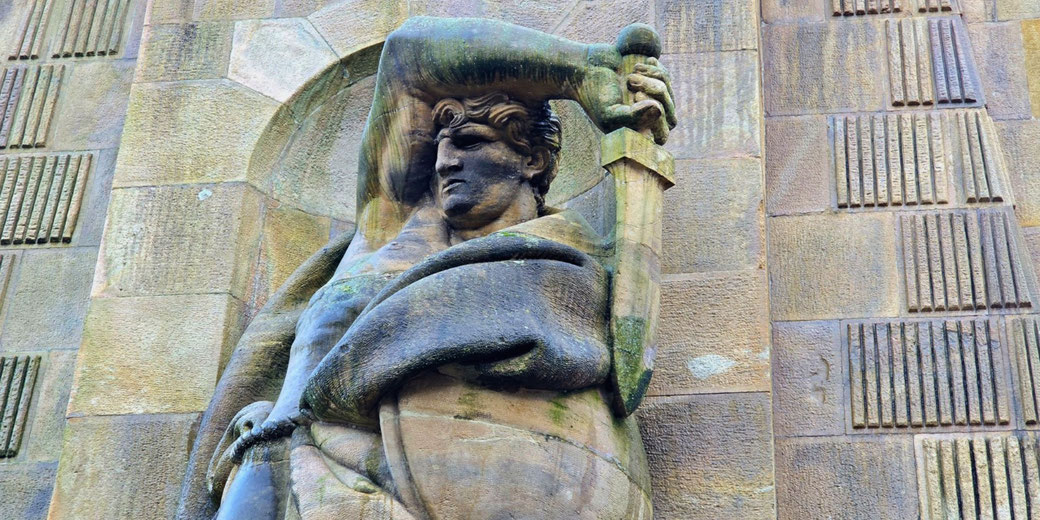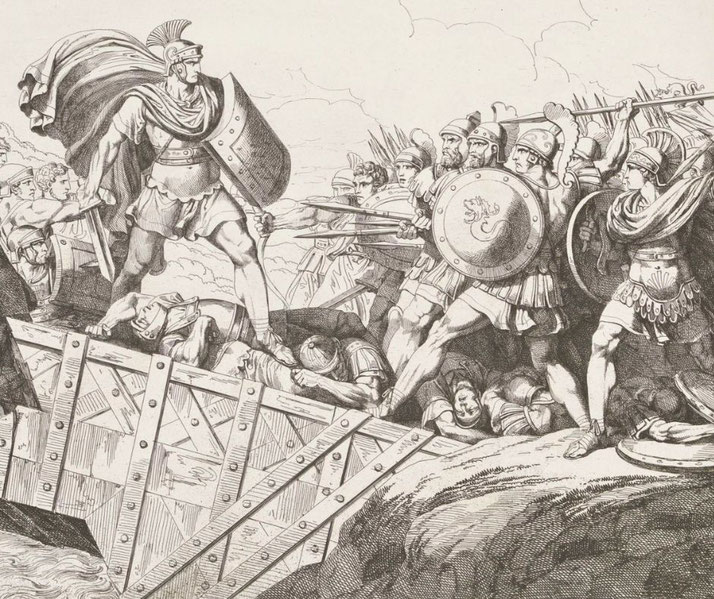How Horatius Cocles' heroic 'last stand' on a bridge saved ancient Rome from disaster

In the early years of Ancient Roman history, there was one hero that stood out among thousands of faceless soldiers: Horatius Cocles.
He was the one-eyed warrior whose deeds on the Pons Sublicius bridge become the standard to which future generations were measured against.
Legend paints him as a bastion of courage, a solitary defender standing against an onslaught to save the nascent Republic.
But how much truth lies within these tales?
Who was this man who purportedly faced down an entire enemy army?
And what can his story tell us about the values and struggles of early Rome?
Who was Horatius Cocles?
Horatius Cocles lived during the early years of the Roman Republic, a period marked by political upheavals, territorial expansions, and frequent skirmishes with neighboring tribes and cities.
Born into a Roman society transitioning from monarchy to republicanism, the exact dates of his birth remain uncertain, but his legend places him in the 6th century BCE, specifically during the reign of the last Roman king, Tarquinius Superbus.
The Tarquin dynasty, known for its tyrannical rule, was eventually overthrown, leading to the establishment of the Roman Republic in 509 BCE.
This new political environment was characterized by a system of checks and balances, with two consuls elected annually to lead the state.
During these transformative years, Rome faced multiple threats from surrounding regions, particularly the Etruscans, who were once allies of the Tarquin monarchy.
The city of Clusium, an Etruscan stronghold, under the leadership of Lars Porsena, sought to reinstate the deposed king and waged war against the nascent Roman Republic.
It was against this backdrop that the young Horatius, a member of the Cocles family, rose to prominence.
His family, although not the most influential in Rome, was known for its military service and dedication to the Roman cause.
The legend of the battle on the Pons Sublicius
The legend of Horatius Cocles centers on a critical event in the early years of the Roman Republic, during the attempted invasion by the Etruscan king, Lars Porsena, in the late 6th century BCE.
Intent on restoring the exiled Tarquin the Proud to the Roman throne, Porsena's forces advanced on the city.
Their path to Rome was obstructed by the Tiber River, over which spanned the wooden Pons Sublicius, a strategically important bridge and the primary entryway into the heart of Rome.

Understanding the significance of this bridge, the Romans recognized that its defense was paramount to prevent the city's capture.
As the Etruscan forces approached, a call to arms was made. Horatius, with the support of two fellow warriors, Spurius Lartius and Titus Herminius, took the frontline.
The trio positioned themselves at the bridge's forefront, ready to confront the approaching Etruscan forces.
As the battle raged, the intensity of the enemy's onslaught tested the Romans' resolve.
Lartius and Herminius, after a fierce resistance, were forced to retreat due to the overwhelming numbers they faced.
Horatius, however, remained unyielding. Alone, he became a bulwark against the relentless tide of Etruscan warriors.
His every swing and parry held them at bay, showcasing not just his combat prowess but also his unwavering commitment to Rome's defense.
Behind him, Roman soldiers hastened to dismantle the bridge, their efforts fueled by Horatius's inspiring stand.
As the bridge neared its collapse, and with the enemy still pressing forward, Horatius made a final, daring move.
He leaped into the Tiber River, swimming to the opposite bank amidst a hail of arrows and spears.
His successful defense and subsequent escape from the enemy became legendary, serving as a beacon of hope and a symbol of the lengths to which a Roman would go to protect their city.
How this became part of Roman mythmaking
Following the heroic defense of the Pons Sublicius, Rome erupted in gratitude and admiration for Horatius's unparalleled bravery.
His act of valor not only prevented the city's capture but also demonstrated the lengths to which a Roman citizen would go to safeguard their homeland.
The Senate, in recognition of his service, awarded Horatius with as much land as he could plow around in a single day, a gesture highlighting the esteem with which they held his actions.
Horatius's story quickly spread throughout the city and its territories, becoming a favored tale recounted to instill values of courage, duty, and sacrifice in Roman youth.
Poets and storytellers immortalized his deeds, ensuring that his legacy would endure for generations.
One of the most notable retellings came from the Roman poet Livius Andronicus, who penned a narrative that celebrated Horatius's heroism.
In subsequent years, monuments and statues were erected in his honor, serving as a constant reminder of the day Rome's fate hung in the balance and the man who rose to its defense.
His story became an integral part of Roman educational curriculum, taught to children as an example of the ideals of Roman citizenship.
Did this story really happen?
The story of Horatius Cocles, while celebrated and revered in Roman culture, has been a subject of scrutiny and debate among historians and scholars.
One argument posits that the tale of Horatius is a piece of propagandist literature, crafted to bolster Roman civic pride and instill a sense of duty and sacrifice among its citizens.
Given the lack of concrete archaeological evidence and the reliance on oral traditions before the story's documentation, some historians believe the legend was exaggerated or even fabricated to serve political or social aims.
Contrarily, other scholars argue that while specific details of the story might have been embellished over time, its core elements are rooted in an actual historical event.
They point to accounts from early Roman historians, such as Livy, who chronicled the tale with a degree of detail that suggests a basis in real events.
The consistency of the narrative across various sources, though with some variations, lends credence to this perspective.
Another aspect of the debate centers on the broader context of Roman-Etruscan relations during the era in question.
Some historians suggest that the story might be a Roman interpretation of a more complex political and military scenario, simplifying the nuances of the conflict for the sake of a compelling narrative.
Ultimately, while the exact details of Horatius Cocles's stand at the Pons Sublicius may never be fully verified, the story's lasting impact on Roman culture is undeniable.
What do you need help with?
Download ready-to-use digital learning resources
Copyright © History Skills 2014-2025.
Contact via email
With the exception of links to external sites, some historical sources and extracts from specific publications, all content on this website is copyrighted by History Skills. This content may not be copied, republished or redistributed without written permission from the website creator. Please use the Contact page to obtain relevant permission.





